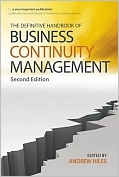| |||||
• polskie
• Zamów informacje o nowościach z wybranego tematu • kontakt |
THE DEFINITIVE HANDBOOK OF BUSINESS CONTINUITY MANAGEMENT 2ND EDITIONHILES D. (EDITOR)wydawnictwo: WILEY, 2007, wydanie IIcena netto: How long would your business survive an interruption? What if operations were destroyed by fire or flood, negative media drives away customers or the company database is stolen or infected by a virus? How well are you prepared to deal with disaster? This comprehensive guide tells you why you need a plan and then will help you put one together, including fully updated, detailed glossary and additional examples from the USA, Australia and Europe. Clearly split into useful sections, the book is easy to navigate. The Definitive Handbook of Business Continuity Management has been revised and updated to reflect new regulations and standards by one of the top international authorities in the field, this is an important book for anyone within the business continuity industry. Seven new chapters include coverage of: US Homeland Security measures relating to IT; UK Civil Contingencies Act relating to business continuity; NFP 16000 (US National Fire Prevention Association 1600 Business Continuity standard); British Standards Institution/Business Continuity Institute Publicly Available Standard 56 and other current and upcoming standards; Other emerging standards: Singapore standard for Disaster Recovery service providers, Australia & New Zealand standards; Pandemic planning With contributions from leading practitioners in the industry, The Definitive Handbook of Business Continuity Management has established itself as an invaluable resource for anyone involved in, or looking to gain a detailed appreciation of, the rapidly emerging area of business continuity and disaster recovery within the corporate environment. Andrew Hiles was founder and Chairman of the first international user
group for business continuity and disaster recovery planning; founding Director and first
Fellow of the Business Continuity Institute; and a founder of the World Food Safety
Organisation. Table of Contents Contributors. Foreword (Lyndon Bird). Preface (David Honour). Introduction (Andrew Hiles). An introduction to business continuity planning (Andrew Hiles). How to use this book (Andrew Hiles). Section One Achieving and maintaining business continuity: an executive overview. 1 What are we planning for? (Geert Vancoppenolle). 2 What is a business continuity planning (BCP) strategy? (Mike O’Hehir). 3 A crisis management perspective of business continuity (Robert Heath). 4 Multilateral continuity planning (Dennis C. Hamilton). 5 Marketing protection: a justifi cation for funding of total asset protection programmes? (Andrew Hiles). 6 Operational risk management (Peter Viner). 7 Business strategy and business continuity planning (Ranjit Kovilinkal Ramakrishnan and Satish Viswanathan). Section Two Planning for business continuity: a ‘how-to’ guide. 8 The business continuity planning methodology (Malcolm Cornish). 9 Project initiation and management (Jayne Howe). 10 Risk evaluation and control: practical guidelines for risk assessment (Ian Charters). 11 Business impact analysis (Peter Barnes). 12 Developing business continuity strategies for the business or work areas (Neal Courtney). 13 Business continuity strategies for financial services (Jillian Simms). 14 Business continuity strategies for manufacturing and logistics (Melvyn Musson). 15 Business continuity for telecommunications (Paul F. Kirvan). 16 Strategies for IT and communications (Michael Smith and Piper-Anna Shields). 17 Planning to recover your data (Thomas Carroll). 18 Strategies for funding recovery (Danny Rowland). 19 Emergency response and operations (Gregg C. Beatty). 20 Developing and implementing the written plan (Andrew Hiles). 21 Awareness and training (Andrew Hiles). 22 BC plan testing (Tim Armit). 23 BC audit (Rolf von Rössing). 24 Selecting the tools to support the process (Lyndon Bird). 25 Coping with people in recovery (Allen Johnson). 26 The missing elements (Andrew Hiles). Appendix 1 Case studies (Peter Barnes and Andrew Hiles). An introduction to the case study section. A1A Storm, earthquake, explosion – a general overview. A1B Living nightmares – some apocryphal tales. A1C World Trade Center explosion 26 February 1993. A1D Hurricane Andrew, Miami – 24 August 1992. A1E Chicago fl oods – 13 April 1992. A1F Thirty seconds of terror! The California earthquake. A1G After the Fire – First Interstate Bank, Los Angeles. A1H One Meridian Plaza, Philadelphia. A1I The Mercantile fire. A1J How fl oods can ruin your day: London College of Printing. A1K Flood highlights. A1L A cautionary tale. A1M It happened to them. A1N Fire highlights. A1O Wessex Regional Health Authority. A1P The Bishopsgate bomb – 25 April 1993. A1Q City bomb blast: St Mary Axe – 10 April 1992. A1R Explosion roundup. A1S Stop thief! A1T Miscellaneous highlights. A1U Lessons in risk management from the Auckland power crisis. A1V Foot and mouth: a preventable disaster. A1W The Madrid rail bombings – 11 March 2004. A1X Istanbul bombings – November 2003. A1Y London bombings – 7 July 2005 (7/7). A1Z Buncefi eld (UK) oil terminal disaster – 11 December 2005. Appendix 2 General guideline notes (Andrew Hiles). A2A Risk: a process approach. A2B Data loss: where did it go? A2C The role of insurance. A2D Five nines: chasing the chimera? A2E Consultancy without tears. A2F Financing business continuity: why is it a problem? A2G Pandemic planning (Malcolm Cornish). Appendix 3 Certification standards. Certification standards for business continuity practitioners. Appendix 4 International perspectives, standards and sources. A4A The implications of recent legislation and standards on business continuity (Andrew Hiles). A4B Business continuity management: an international perspective from the BCI (Lyndon Bird). A4C Business continuity planning in Asia (Alan Craig). A4D Useful international contacts. Glossary of general business continuity terms. Index. 666 pages, Hardcover
Po otrzymaniu zamówienia poinformujemy pocztą e-mail lub telefonicznie, |


